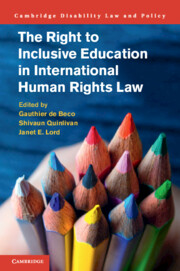Book contents
- The Right to Inclusive Education in International Human Rights Law
- Cambridge Disability Law and Policy Series
- The Right to Inclusive Education in International Human Rights Law
- Copyright page
- Contents
- Notes on Contributors
- Acknowledgements
- Preface by Theresia Degener
- The Arthur Cox Foundation
- 1 Introduction
- Part I Background
- Part II Theoretical Foundations
- A Conceptual Issues
- 4 Moving towards Schools for All
- 5 Drafting Article 24 of the Convention on the Rights of Persons with Disabilities
- 6 The Expressive Dimension of the Right to Inclusive Education
- B Substantive Issues
- Part III Implementation
- Part IV Practice
- Index
4 - Moving towards Schools for All
Examining the Concept of Educational Inclusion for Disabled Children and Young People
from A - Conceptual Issues
Published online by Cambridge University Press: 15 April 2019
- The Right to Inclusive Education in International Human Rights Law
- Cambridge Disability Law and Policy Series
- The Right to Inclusive Education in International Human Rights Law
- Copyright page
- Contents
- Notes on Contributors
- Acknowledgements
- Preface by Theresia Degener
- The Arthur Cox Foundation
- 1 Introduction
- Part I Background
- Part II Theoretical Foundations
- A Conceptual Issues
- 4 Moving towards Schools for All
- 5 Drafting Article 24 of the Convention on the Rights of Persons with Disabilities
- 6 The Expressive Dimension of the Right to Inclusive Education
- B Substantive Issues
- Part III Implementation
- Part IV Practice
- Index
Summary
- Type
- Chapter
- Information
- Publisher: Cambridge University PressPrint publication year: 2019
- 2
- Cited by



